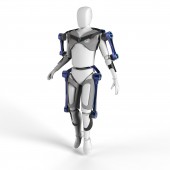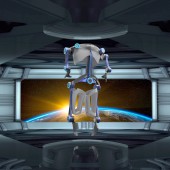Orpheus Exoskeletal Exercise Device by Mehmet E. Ergül |
Home > Winners > #54239 |
 |
|
||||
| DESIGN DETAILS | |||||
| DESIGN NAME: Orpheus PRIMARY FUNCTION: Exoskeletal Exercise Device INSPIRATION: In outer space, the only pivot point is our own body. So the products should have a harmony with the human body itself. The main inspiration was Aerial Dancers and Ballets, their forms and body positions while dancing are very similar to the moves of the astronauts in orbit. For achieving the perfect product/user relationship ergonomics wise, exoskeletons inspired the design by form and technology. UNIQUE PROPERTIES / PROJECT DESCRIPTION: The Orpheus is an exercise device designed for the International Space Station and future Spacecrafts, which has some major improvements superior to Ared. (currently used exercise equipment at the Iss). The Orpheus is designed with today’s technology to create the best user/product relationship; while reducing the current mass and volume of the product, which makes a more efficient space for the interior of the Space Shuttle. OPERATION / FLOW / INTERACTION: The operation is made by the software which stores all the results of the astronauts. According to the exercise program and the user, the device adapts its properties (i.e.: resistance, height, fit to the body). The user performs the exercise, while the device is giving proper resistive force to the muscles. PROJECT DURATION AND LOCATION: The project started as a graduation project in February 2016 for Industrial Design 4th year studio. After the graduation exhibition in June 2016; Orpheus has been exhibited in Design Week Turkey in Istanbul, October 2016. After the Design Week exhibition, the project exhibited in Turkey Research&Development and Innovation Week, November 2016. |
PRODUCTION / REALIZATION TECHNOLOGY: The concept product is basically an exoskeleton which we wear to our body. In this way, we achieve an excellent user-product consistency. A major advantage of the Orpheus is its volume. When we compare the products volume with Ared, the decrease is approximately %75. The joints of the product possess electronic motors and a gearbox attached to the motor. Aluminum structure and carbon-fiber parts have been combined for the body parts. SPECIFICATIONS / TECHNICAL PROPERTIES: Dimensions of the product are 1350 mm x 370 mm x 670 mm. The brushless motors located at the joints are combined with gearbox systems which can create a 90 lbs. force per joint during the exercise. The given dimensions are extremely less, compared to the current device at the International Space Station. Material Selection has been made according to plastic deformation and shear stress results. TAGS: Exercise, Aerospace, Sports, Spacecraft, Exoskeleton, Iss, RESEARCH ABSTRACT: The research period of the project started in December with relative articles about the Ared, then continued with analyzing other Exoskeleton devices in market. Some data's collected from several other people working in cybernetics & prosthesis industry and also from fitness industry. The results combined in Cad models and simulations. CHALLENGE: In a designer perspective, designing a concept product for space is an extremely difficult task to do. Every move has its own concerns and procedures. Trying to be productive in between those lines was the most difficult part of the project. Also having information about the space industry is hard to achieve, since the products or informations are legally protected by governments & organizations via patents or laws. ADDED DATE: 2017-02-21 12:38:48 TEAM MEMBERS (1) : IMAGE CREDITS: Main Image and Optional Image #4 : The images has been used in accordance to "Non Copyright Images" PATENTS/COPYRIGHTS: Patent process is currently under evaluation by the Tpe ( Tuskish Patent Institute). |
||||
| Visit the following page to learn more: http://www.grau.design | |||||
| AWARD DETAILS | |
 |
Orpheus Exoskeletal Exercise Device by Mehmet E. Ergül is Winner in Cybernetics, Prosthesis and Implant Design Category, 2016 - 2017.· Read the interview with designer Mehmet E. Ergül for design Orpheus here.· Press Members: Login or Register to request an exclusive interview with Mehmet E. Ergül. · Click here to register inorder to view the profile and other works by Mehmet E. Ergül. |
| SOCIAL |
| + Add to Likes / Favorites | Send to My Email | Comment | Testimonials | View Press-Release | Press Kit |
Did you like Mehmet E. Ergül's Cybernetics Design?
You will most likely enjoy other award winning cybernetics design as well.
Click here to view more Award Winning Cybernetics Design.








